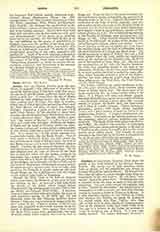

Jordan, The (in Hebrew Yarden, from the root Yarad, to descend).—The difference of elevation between the highest point of this river (1847 feet above the sea-level) and its lowest (1286 feet below the sea-level) is 3133 feet. It issues from the side of Mount Hermon by three principal sources: the Nahr el Hasbani, coming from Hasbeya; the Nahr el Leddan, which rises at Tell el Qadi (the ancient Lais-Dan); and the Nahr Banias, the glory of what was Caesarea Philippi. Formed at a point about five and a half miles below Banias, by the junction of these three streams, the Jordan enters Lake Hilleh about nine and a third miles lower down. This lake, which is probably “the waters of Merom”, is rather more than three and a half miles in length. Between the Bahrat el Huleh and the Lake of Tiberias, nearly ten miles, the Jordan is clear, and in some places reaches a width of over twenty yards and a depth of nearly seventeen feet. It is crossed by a bridge which connects Damascus with Galilee, the Jisr Benat Yaqub. Near et Tell, which is Bethsaida Julias, the river enters the Sea of Genesareth, which is 682 feet below the level of the Mediterranean and is more than thirteen miles in length. Leaving the lake towards Samakh, the Jordan commences its innumerable wanderings. The direct distance from the Lake of Tiberias to the Dead Sea is sixty-five miles, but the Jordan, owing to its sinuosities, has a course of 200 miles. At a little distance from where it leaves the lake there are remains of two bridges, Jisr es Semakh and Jisr es Sidd, and in this reach of the river it is still fordable at many points. At about six and a quarter miles from the lake, after receiving the Yarmuk, it passes under an old Arab basalt bridge, the Jisr el Mudjamieh, and the bridge of the railroad from Caiffa to Damascus.
Beyond the Wadi ‘Arab is the ford of Abarah, where some locate the Bethbera of the story of Gedeon (Judges, vii, 24). At five and a half miles from the mouth of the Jalud, which passes Beisan (Scythopolis), the Jordan passes between Tell es Sarem (Salim) and Tabagat Tahil (Pella). It receives, three and three-quarter miles from Salim, the water of such important springs as the Beda and ‘Ain esh Shemsieh, where the first Christian tradition placed Ennon; “John also was baptizing in Ennon near Salim” (John, iii, 23). Umm el Amdan, which is very near, was supposed, in the fourth century, to be the Salem of Melchisedech. Over against these springs the Wadi Yabis rushes down precipitately, the name of which recalls Jabes Galaad, delivered by Saul (I Kings, xi). From the lake to this point the whole valley is cultivated; thence to Sartabeh, the mountains of Samaria reach to the river. Opposite Sartabeh is the confluence of the Nalir ez Zerqa (Jabbok), and just below are to be seen the ruins of the Roman bridge of Damieh and the ford of the same name which must have played a part in the well-known episode of Sibboleth (Judges, xii, 5, 6). The utensils and the columns of the Temple of Solomon were cast near here (III Kings, vii, 46). From Damieh onwards the valley ceases to be cultivated; the waters of the Jordan, disturbed by rapids, become yellow and muddy. A two-hours’ journey northeast of Jericho are to be found the wooden bridge and the ford of Ghoranieh, where the great highways of Galaad and Moab meet. The Greek monastery of Qars el Yehud, two and a half miles farther down the river, marks the traditional scene of the passage of the Hebrews (Jos., iii, 9-13) and of the baptism of Christ (Matt., iii). The scene of the ministrations of St. John the Baptist, however, has been very plausibly placed at the ford of the Ghoranieh, which has always been more frequented. In its lower portion the river is swelled by many affluents, which formerly watered a part of the Kikkar, whither Lot came when he parted from Abraham; these affluents are the Wadi Kelt, the Wadi Kefren, and the Wadi Nimrin.
The Jordan, called by the Arabs esh Sheriat el Kebir (the great drinking-place), flows between steep banks of rather brittle clay. The lower part of its basin is called the Zor, the bottom of the valley is the Ghor. It is fringed with trees and shrubs—poplar, tamarisk, rhododendron, agnus castus, apple of Sodom—and its waters contain a great many fish—various species of capocta, the barbus canis, the cyprinodon, and a kind of catfish (silurus). Vipers, scorpions, porcupines, jackals, wild boars, ibexes, panthers (nimr), and a great variety of birds are found in the neighboring thickets. A tropical temperature predominates. The water of the Jordan contains a saline residuum, chlorine, sodium, sulphuric acid, and magnesia. The floods of the river occur from February to May. Its width is very variable: at Ghoranieh scarcely more than twenty-seven yards; at the ford of el Henu as much as forty-five to fifty-five yards; at its mouth about eighty yards. The volume of water brought to the Dead Sea by the Jordan is calculated to be, on the average, 883 cubic feet per second.
F. M. ABEL

